Beckhoff FC520x
The FC520x is a DeviceNet compliant Fieldbus card with one (FC5201) or two independant channels (FC5202). It can be driven as both a DeviceNet master and/or a DeviceNet slave. In master operating mode, it can exchange data with up to 63 slaves. All IO operating modes defined by DeviceNet are available as options for the exchange of IO data. Support of the Offline Connection Set provides access to a high-performance diagnostic interface. The "Auto-Device-Replacement" function makes it easy to replace faulty nodes.
Context menu
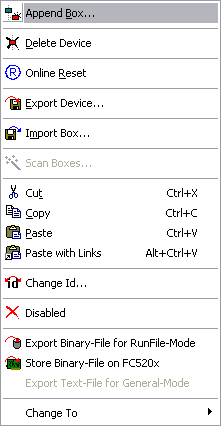
Append Box... <Insert>
Adds DeviceNet slaves (boxes). For an Overview of all currently supported DeviceNet devices, please see...
Delete Device... <Del>
Removes the FC520x fieldbus card and all subsidiary elements from the I/O configuration.
Online Reset
Initiates an online reset on the DeviceNet Master.
"FC5200" tab
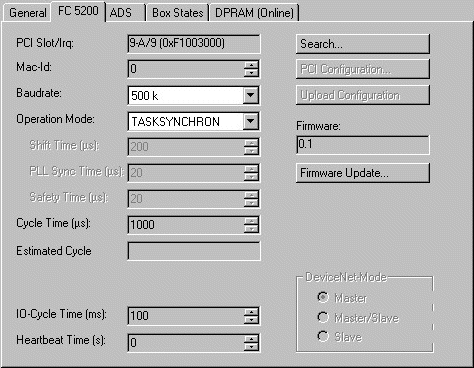
PCI Slot/Irq: Shows in which logical PCI slot the card was detected and which IRQ is assigned to it. The IRQ is unused.
Search...: Searches for all connected FC520x channels. Select those required. In the case of an FC5202 both channels A and B appear. These behave in logical terms like two FC5201 cards.
PCI Configuration …: In which the address of the FC520x is set in the lower memory area (below 1 MB) of the PC.
Upload Configuration …: Scans the DeviceNet network and adds all found devices (boxes cannot be added). In the case of Beckhoff boxes, reads the configuration precisely. Searches external devices to find the corresponding EDS file.
Firmware: Shows the current firmware version of the FC520x.
Firmware Update...: Update the FC520x card firmware version here.
Stations No.: Each DeviceNetdevice requires a unique station number (MAC-ID)- including the master.
Baudrate: Set the DeviceNet Baudrate here. Select one of the following: 125kBaud, 250 kBaud and 500 kBaud
Operating Mode: Set the CDLSYSNCHRON operating mode, the highest priority task linked with the corresponding device controls the DeviceNet cycle and is thereby synchronized with the fieldbus. All other tasks are served asynchronously via corresponding buffers.
Shift-Time: The DeviceNet cycle is started by a real time timer, but only if at the time of the timer overflow, the PC application has already sent the output data (transfer of output data). This means that the real time timer on the card and the highest priority TwinCAT task are using the same cycle time but are shifted together by a predetermined time difference, whereby the shift time must be greater than the maximum TwinCAT jitter plus the maximum mapping time (see Equi Diag tab).
PLL-Sync-Time: As the card’s real time timer and the highest priority TwinCAT task gradually diverge, the card’s real time timer must be readjusted. The PLL Sync time gives thresholds at which, once exceeded, the card’s real time timer is readjusted. A small PLL Sync time exerts a strong shift on the cycle time of the card’s real time timer, producing a significant jitter on the fieldbus.
Safety-Time: Idle time on the bus before the start of the next cycle.
Cycle Time: Displays the cycle time of the corresponding highest priority task.
Estimated Cycle: Displays the expected DeviceNet cycle time.
IO-Cycle Time: Sets the cycle time for the I0 connections. This value is used as the default value for newly added boxes.
Heartbeat Time : Cycle Time for DeviceNet Heartbeat Messages. Heartbeat messages allow monitoring of the nodes within the network.
”ADS” tab
The FC520x is an ADS device with its own net ID, which can be changed here. All ADS services (diagnosis, non-cyclical communication) going to the FC520x must address this net ID.
”Box States (Diag)” tab
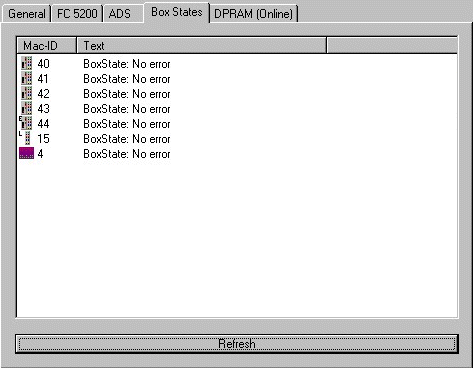
Displays an overview of all current box statuses.
Input Diagnosis
The FC520x automatically provides several diagnostic variables which describe the status of the card and the DeviceNet network:
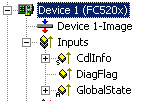
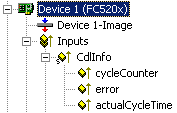
CdlInfo:
CdlInfo.error: Shows the number of slaves with which data exchange cannot be carried out. The box status of the slaves must only be checked if this value is not equal to 0.
CdlInfo.cycleCounter: Is incremented at the end of each DeviceNet cycle. This variable allows you to determine whether the last cycle was completed before the task was begun
CdlInfo.actualCycleTime: Shows the current cycle time in 4/25 µs. This variable is updated only when all slaves are involved in the data exchange (also when CdlInfo.error is 0)
DiagFlag: Shows whether the diagnostics information on the card has changed. This can be read off using ADS Read. For that purpose, specify the net ID of the FC520x, the port number 200 and the IndexGroup 0xF100. The IndexOffset and the length then relate to the diagnostic data.